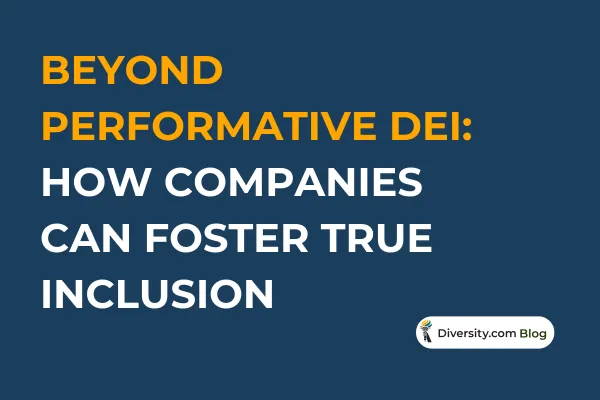
Beyond Performative DEI: How Companies Can Foster True Inclusion
Diversity, Equity, and Inclusion (DEI) initiatives have become widespread, but many organizations struggle to move beyond performative gestures to create genuine, sustainable inclusion.
Employees and job seekers are increasingly scrutinizing companies for authentic DEI efforts rather than symbolic actions.
This article explores how companies can go beyond performative DEI to build truly inclusive cultures, ensuring that diversity efforts create lasting impact rather than superficial compliance.
1. Recognizing Performative DEI
Performative DEI refers to diversity initiatives that prioritize optics over genuine systemic change.
These efforts often appear progressive but fail to address structural inequalities within organizations. Common characteristics include:
Performative DEI refers to symbolic efforts that lack real structural change. These initiatives often:
🚨 Prioritize optics over impact – Companies promote DEI externally but fail to implement meaningful internal policies.
🚨 Rely on tokenism – Hiring a few diverse employees without changing workplace culture.
🚨 Ignore systemic barriers – Failing to address pay gaps, promotion disparities, or biased workplace policies.
🚨 Lack accountability – No clear metrics to measure progress or leadership commitment.
🔎 Real-World Example
A 2023 McKinsey study found that while 70% of companies claim to prioritize DEI, only 20% of employees in these organizations reported meaningful workplace change. The study highlighted a disconnect between leadership messaging and actual policy implementation, leading to disengagement. (McKinsey)
2. The Business Case for Genuine Inclusion
Companies that prioritize true inclusion experience:
✅ Higher employee engagement – Inclusive workplaces see up to 3x higher retention rates.
✅ Better innovation & decision-making – Diverse teams outperform homogenous ones by 30% in problem-solving.
✅ Stronger employer branding – Job seekers increasingly prioritize companies with proven inclusion strategies.
🔎 Case Study
Salesforce implemented inclusive leadership training, transparent pay equity audits, and accountability reports—leading to a significant boost in employee trust and engagement. (Forbes)
3. Strategies for Moving Beyond Performative DEI
To foster real inclusion, companies must go beyond symbolic efforts and commit to sustained, systemic change.
The following strategies are proven to drive long-term DEI impact and employee trust.
To foster real inclusion, companies must commit to sustained, systemic change rather than one-off initiatives.
1. Embed DEI Into Leadership & Accountability
📌 Tie DEI to leadership evaluations – Ensure leaders are assessed on DEI progress as part of their performance metrics.
📌 Publicly report DEI metrics – Transparency builds trust and accountability.
📌 Incorporate DEI into business strategy – DEI should not be a separate initiative but an integral part of company goals.
Example: Microsoft ties executive bonuses to DEI progress, ensuring leaders have a tangible stake in fostering inclusion. (Harvard Business Review)
2. Address Systemic Barriers in the Workplace
📌 Eliminate pay gaps – Conduct regular pay audits and adjust compensation disparities.
📌 Diversify leadership pipelines – Offer mentorship and sponsorship programs for underrepresented employees.
📌 Revamp promotion & retention strategies – Ensure all employees have equal access to career growth opportunities.
Example: Patagonia revamped its leadership pipeline to increase female and BIPOC representation in executive roles. (SHRM)
3. Foster an Inclusive Workplace Culture
📌 Ensure psychological safety – Employees should feel comfortable sharing experiences without fear of backlash.
📌 Support Employee Resource Groups (ERGs) – Provide ERGs with budgets, leadership support, and decision-making influence.
📌 Re-evaluate workplace policies – Review parental leave, flexible work, and cultural observance policies to ensure inclusion.
Industry Data: A 2022 report by McKinsey found that companies with well-supported ERGs saw a 25% increase in employee retention and a 15% boost in overall job satisfaction compared to those without structured DEI programs. (McKinsey)
📌 Ensure psychological safety – Employees should feel comfortable sharing experiences without fear of backlash.
📌 Support Employee Resource Groups (ERGs) – Provide ERGs with budgets, leadership support, and decision-making influence.
📌 Re-evaluate workplace policies – Review parental leave, flexible work, and cultural observance policies to ensure inclusion.
Example: Spotify implemented mental health support, flexible work schedules, and dedicated ERG funding, leading to increased employee satisfaction. (Fast Company)
Final Thoughts: Prioritizing Meaningful DEI Over Optics
Companies that move beyond performative DEI embed inclusion into every aspect of their business, from leadership decisions to everyday workplace policies. The key to sustained DEI success lies in accountability, systemic change, and continuous engagement.
Key Takeaways:
✅ Performative DEI focuses on optics rather than meaningful change.
✅ Genuine inclusion leads to higher engagement, innovation, and retention.
✅ Leadership accountability, pay equity, and inclusive culture drive real DEI impact.
✅ Transparency, workplace policies, and ERG support sustain inclusion efforts.
🚀 Build a Truly Inclusive Workplace
💼 Employers: Looking to create lasting DEI impact? Post inclusive job listings on Diversity.com today!
🔎 Job Seekers: Want to work for a company that values true inclusion? Browse top DEI-focused employers now!

